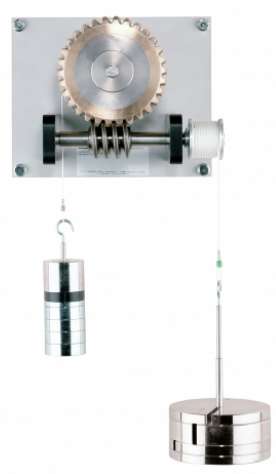EM-201 | Worm and Wheel Apparatus
- Function and design of worm gears.
- Bronze worm wheel.
- Steel worm.
- Two aluminum cable drums.
- Worm, worm wheel, and pulleys mounted on ball bearings.
- Anodized aluminum base plate.
- Length: 250 mm.
- Width: 150 mm.
- Height: 200 mm.
- Weight: 22 kg.
Worm gears are a category of helical rolling gears that are classified as transmission or conversion elements within machine elements. This type of gear comprises the usual driving worm and the driven worm wheel. Worm gears are quiet and have a damping effect. They are smaller and easier to operate than spur gears or bevel gears of the same performance and gear ratios. The experimental unit is used to study their torque ratios and efficiency. The transmission ratio of the gear can be determined. The basic concepts of tooting such as tooth number and gear number, module, pitch and center distance are illustrated. The worm wheel and worm are mounted on ball bearings. The forces are generated by weights and can be varied quickly and easily.
Experimental Capabilities
- Development of the main variables and relationships in a worm gear.
- Investigation of transmission ratio, torque, friction and self-locking.
- Determine the efficiency.
Scope of Delivery
- 1 experimental unit.
- 1 worm.
- 1 worm wheel.
- 1 set of weights.
- 1 set of instructional material.
- Cable drum:
- Worm shaft diameter: Ø=40mm.
- Worm wheel shaft diameter: Ø=120mm.
- Worm gear:
- Center distance: 80mm.
- Gear ratio: 30:1.
- Module: m=4mm.
- Number of gears: 1.
- Force transmission: 10.
- Weights on the worm side:
- 1x 50N.
- 1x 20N.
- 2x 10N.
- 1x 10N (hanger with equalizing mass).
- Weights on worm wheel:
- 1x 5N.
- 4x 2N.
- 1x 1N.
- 1x 0.5N.
- 1x 0.5N (hanger).
Any questions? We are happy to help...
+49 40 670 854 - 0
sales@gunt.de
Newsletter
About Us
EduTech Lahore excels in designing and supplying cutting-edge equipment for Engineering Education in Mechanical,Polymer
Chemical, Civil and Control Engineering. Focused on meeting the demand for quality education, we offer cost-effective solutions for the latest teaching equipment.
Contact Info
Head Office (Asia)
EduTech
Lahore
- EduTech Lahore, 2nd Floor, Plaza No.1009, Block-F, Commercial Area, State Life Insurance Employees Cooperative Housing Society Limited, Lahore.
- info@edutechlahore.com
- +92 321 88 35034
- (042) 35460635
Regional Partner Office (UK)
- Jactin House 24 Hood Street Ancoats M4 6WX
- info@edutechlahore.com
- +44 0161 676 7299
Sales Partner (Middle East) GCC International FZC
- G3.Al Awail building, Indusrial Area Al jurf 2. Ajman United Arab Emirates
- sales.uae@ syptechnologies.com
- +971 0161 676 7299

